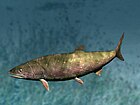Parasemionotus
| Parasemionotus Temporal range:
| |
|---|---|

| |
| Parasemionotus from the Sakamena Formation of Madagascar | |
| Scientific classification | |
| Kingdom: | Animalia |
| Phylum: | Chordata |
| Class: | Actinopterygii |
| Order: | †Parasemionotiformes |
| Family: | †Parasemionotidae |
| Genus: | †Parasemionotus Piveteau, 1929 |
| Type species | |
| †Parasemionotus labordei (Priem, 1924)
| |
Parasemionotus is an extinct genus of prehistoric bony fish that lived in the Induan age of the Early Triassic epoch in what is now Madagascar.[1] It is the name giving genus of the family Parasemionotidae and the order Parasemionotiformes. This clade includes, among others, the genera , Candelarialepis, Jacobulus, Lehmanotus, , Stensioenotus, , Thomasinotus, Watsonulus, and possibly additional genera like . Parasemionotiforms had a global distribution during the Early Triassic. Species of this family are found in Greenland, Madagascar, Canada, India, China, United States, and possibly Australia.
The type species Parasemionotus labordei was first described under the name Semionotus labordei by . Jean Piveteau later erected the new genus name Parasemionotus for this species. It is not closely related with Semionotus.
See also[]
- Prehistoric fish
- List of prehistoric bony fish
References[]
- ^ a b Sepkoski, Jack (2002). "A compendium of fossil marine animal genera". Bulletins of American Paleontology. 364: 560. Retrieved 2009-02-27.
- Parasemionotiformes
- Early Triassic fish
- Prehistoric animals of Madagascar
- Extinct animals of Europe
- Prehistoric ray-finned fish genera
- Prehistoric ray-finned fish stubs
- Triassic fish stubs

